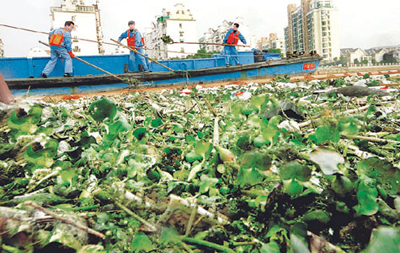| Home / Environment / News | Tools: Save | Print | E-mail | Most Read |
| Weed Sparks River Alert |
| Adjust font size: |
Sanitation workers clean up water hyacinth in the An outbreak of the dreaded pest water hyacinth has spread to the The floating weed was attracted to the spot by intake pipes for Water hyacinth has long been a headache for the public sanitation bureau. The plant clogs waterways, damages the environment, and kills fish by consuming all the oxygen in the water. "The winter outbreak happened in mid-November this year, a little later than previous years," said Yu Hai, a bureau section chief. "We expect the outbreak to be over by early January." Extra clean-up teams have been assigned to collect the plant, but so far there has been no adverse effects on Yu said plants floated to the middle of the river near In just two weeks to December 3, officials have collected more than 30,000 tons of the plant. The total amount of last year's winter outbreak was 46,000 tons. The only way to deal with hyacinth is to collect and then bury them, Yu said, although some innovative methods have been tried in recent years. One Yu said a plan was floated to introduce an insect to eat the plant, but was shelved. But a scheme to use the plant to generate electricity is still being considered. The government made eradication of the plant a priority after a severe outbreak in 2002. Officials collected 120,000 tons of water hyacinths that year. "Many ferries couldn't berth due to the heavy green plant," Yu said. Autumn is the best season for hyacinths to grow. When mature they break into clusters and flow from the upper reaches of the Yangtze River to downtown (Shanghai Daily December 7, 2006) |
| Tools: Save | Print | E-mail | Most Read |
 |
| Related Stories |
|
|
